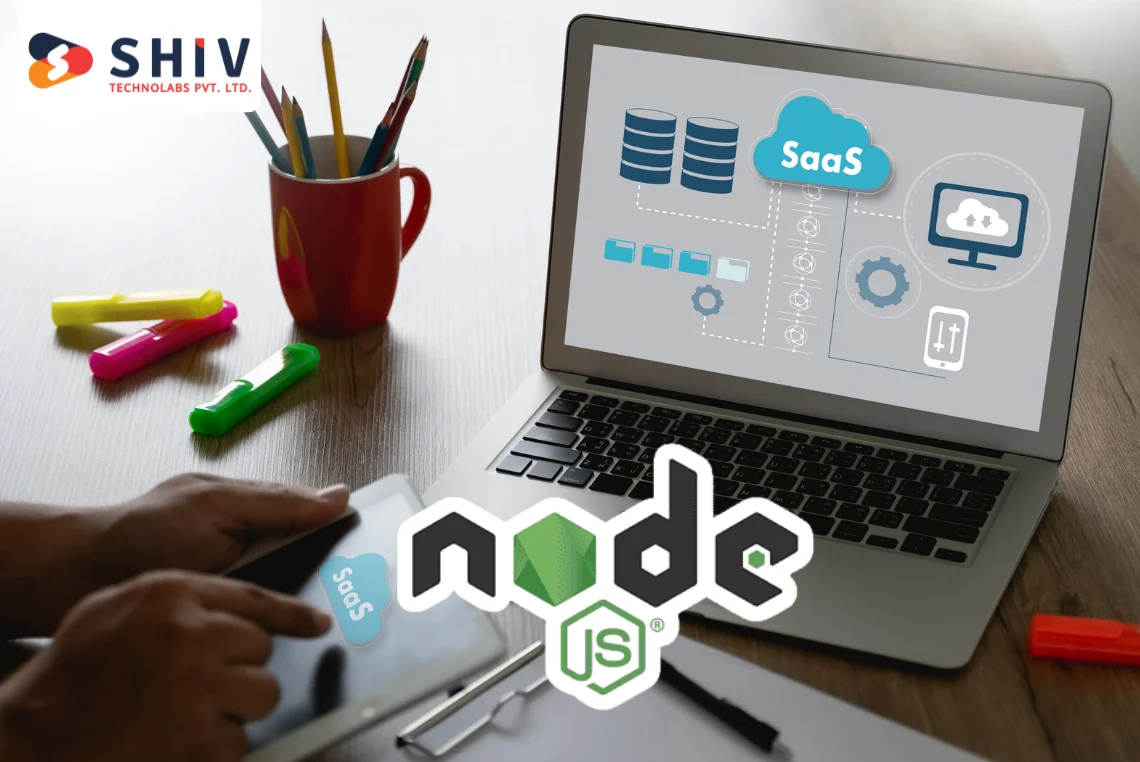Table of Contents
U.S. SaaS founders pick Node.js to ship faster, scale reliably, and control costs from MVP to growth. If you need a Node.js development company in USA, our senior engineers plan clean sprints and deliver stable releases. We support product leaders with crisp reviews, predictable timelines, and hands-on help from discovery to scale.
Node.js reduces friction by running one language across the stack, which cuts handoffs and speeds feedback loops. This makes Node.js for SaaS development in USA, where teams ship weekly and need tight performance under spikes. For SaaS backend development USA, Node.js brings non-blocking I/O, lean memory use, and reliable CI/CD tooling.
With Node.js backend development, founders validate ideas quickly and roll out improvements without stalling the roadmap. Our delivery model keeps code readable, covered by tests, and ready for cloud pipelines across environments. That foundation supports demos, onboarding waves, and sales pushes without hurting uptime or user satisfaction.
Why Do SaaS Startups in the USA Rely on Node.js for Backend Development?
Using one language across frontend and backend cuts context switching and keeps handoffs simple for small, busy teams. The non-blocking event loop handles high concurrency while keeping endpoints responsive during traffic spikes and sudden bursts. A rich ecosystem with mature tooling reduces setup time and supports quick, reliable releases across staging and production.
What Makes Node.js the Right Choice for SaaS Platforms?
Fast iteration, real-time features, and variable traffic define modern SaaS, making Node.js for SaaS platforms a smart pick. Teams gain speed without heavy overhead, keeping product releases frequent and performance steady during peak demand.
- Faster time-to-market with JavaScript full-stack capability
- Handles multiple concurrent users
- Lower resource consumption
- Easy third-party integration
Startups ship faster with shared patterns, robust tests, and reusable components across the entire stack. Our architects suggest practical libraries for payments, auth, queues, logging, and metrics to keep releases predictable.
When traffic jumps, non-blocking handlers keep endpoints responsive without oversized servers or fragile workarounds in production. We plan risk upfront, pair with your developers, and keep releases aligned with runway and market windows.
Teams integrate analytics, payments, and authentication quickly using mature SDKs, stable APIs, and proven adapters. That speed tightens feedback loops, reduces churn risk, and supports Node.js for SaaS platforms with lean budgets.
Small teams gain shared context, quicker code reviews, and faster fixes because everyone speaks JavaScript end to end. You keep product momentum high while protecting quality across development, staging, and production environments daily.
How Does Node.js Help SaaS Businesses Grow in the USA?

Node.js lets SaaS teams ship features quickly while keeping apps responsive under real traffic peaks. This is how Node.js helps SaaS businesses grow: shorter release cycles, faster feedback, and steady performance during busy periods. Founders reduce costs, protect uptime, and support expansion without constant rewrites or risky migrations.
What Are the Core Benefits for Startups?
Real-time updates for better user engagement
Real-time dashboards, timely alerts, and clear in-app actions keep users active during peak hours and busy sessions. They return more often, spend longer in product, and complete tasks without waiting for slow refreshes. That steady activity lifts retention, reduces churn, and turns more trials into reliable month-over-month revenue.
Cost efficiency for MVP and scaling
Shared JavaScript skills and lighter runtime demands reduce cloud costs across MVP builds and later growth. Fast sprints and reusable components help small teams deliver more features within tight budgets and short timelines.
Cross-platform compatibility
Teams reuse server logic across web clients, mobile backends, and internal services to accelerate releases consistently. Shared patterns simplify maintenance and make long-term product roadmaps easier to manage for small teams.
Fast performance with asynchronous processing
Asynchronous processing reduces waiting on databases, queues, and APIs, so endpoints stay responsive during peak periods. Users see quicker actions during launches, demos, and campaigns that drive heavy traffic across channels.
Easier developer collaboration
A single language across the stack keeps code reviews clear and handoffs short between teammates daily. This shared context accelerates planning, reduces blockers, and supports dependable feature releases each sprint consistently.
How Node.js Improves SaaS Scalability and Speed
The event loop processes many I/O requests without blocking threads, so servers handle more users efficiently. Asynchronous patterns keep work moving while calls to databases, queues, or third-party APIs finish reliably. This design reduces idle time and supports quick responses during heavy load across shared resources.
Clustering spreads traffic across CPU cores, while process managers restart workers fast after failures automatically. Autoscaling policies map traffic patterns to cluster size, connection pools, and cache rules safely during peaks. Our team plans capacity and selects libraries that match business goals, growth targets, and reliability needs.
Performance Metrics
| Metric | Traditional Stack | Node.js Backend |
|---|---|---|
| Response Speed | Moderate | High |
| Scalability | Limited | Excellent |
| Cost | High | Lower |
For SaaS backend development USA teams, these practices support growth without constant refactoring or new stacks. We write clear metrics, load tests, and alerts that keep service levels steady through launches and onboarding waves. When you need extra help, our senior engineers pair with your developers and tailor a practical growth plan.
Why Is Node.js Ideal for Real-Time SaaS Applications?
Node.js fits real-time workloads because its event-driven core responds quickly under heavy, chatty user activity. For Node.js for real-time SaaS applications, persistent connections keep updates flowing across dashboards, chats, and notifications with low delay.
Examples include:
- Chat and collaboration tools
- CRM dashboards
- IoT platforms
- Live data feeds and notifications
Technical note: WebSockets create a steady two-way link, so servers push data without constant polling or extra requests. The event loop dispatches small tasks as data arrives from databases, queues, or third-party APIs. Most teams pair Socket.IO with Redis pub/sub and a load balancer to scale broadcasts safely during growth.
Real-time apps often need presence, typing states, and backpressure when messages spike during peak hours. Node.js pairs well with message queues and rate limits that keep systems stable without heavy servers. That mix supports clear chat flows, quick dashboards, and alerts that land on time for every user.
How Do U.S. Startups Benefit from Node.js Developers?
Hiring skilled Node.js developers in USA brings faster communication, tight feedback loops, and shared language across teams. Timezone alignment and local standards help product managers plan releases cleanly and keep quality high.
What to Expect from Professional Node.js Teams in the USA?
Professional Node.js teams focus on product goals, delivery speed, and code clarity from sprint to release. They speak JavaScript end to end, which cuts handoffs and helps small groups move quickly under real deadlines.
- Expertise in JavaScript frameworks
- Familiarity with cloud and API integrations
- Experience in scaling SaaS platforms
Expect practical tool choices, readable modules, and coverage where risk is highest across critical endpoints. Teams document patterns that speed reviews, reduce churn, and support clear handoffs between product and engineering. They add metrics and alerts that flag issues early, so fixes arrive before users feel pain.
For growing platforms, we map traffic to cluster size, caches, and connection pools with care. We load test with scripts that mirror live usage, then tune hotspots without major rewrites or downtime. That plan keeps pages responsive during launches, onboarding waves, and campaigns that drive sudden spikes.
If you already have engineers, we pair and tackle risky modules without blocking ongoing work. If you are starting fresh, we set logging, metrics, and release steps that scale with growth. These habits protect budgets, keep users happy, and support steady progress from MVP to paid adoption.
What Challenges Can SaaS Startups Face with Node.js – and How to Overcome Them?

Node.js brings speed, yet fast growth can expose weak spots that slow releases and frustrate teams. We surface risks early, agree on small fixes, and keep apps responsive during heavy traffic. This mindset fits backend development for SaaS, where frequent updates and rising load are normal parts of growth.
CPU-intensive tasks
Move heavy jobs to worker threads or background services, so API routes stay quick for users. Add queues and backpressure, then process exports, reports, or media work without blocking requests during busy periods.
Security risks
Use HTTPS everywhere, sign tokens with JWT, and validate inputs on every boundary consistently. Rotate secrets, throttle suspicious calls, and log key auth events to spot abuse quickly and act fast.
Code maintenance
Break large codebases into small services with clear contracts and versioned interfaces for safe change. Share utilities, document decisions, and track health to keep refactors steady during tight sprints and launches.
Which Successful SaaS Companies Use Node.js in the USA?
Many U.S. SaaS brands run Node.js for speed, steady performance, and quick product changes at scale.
Netflix
Netflix uses Node.js in microservices that route requests and manage traffic during premieres and weekend surges. Teams test endpoints quickly and coordinate releases without long waits or fragile scripts during peak seasons.
Trello
Trello powers real-time boards where cards, comments, and lists update quickly across browsers and devices. Socket channels carry events, so teammates see changes without reloads or confusing refresh rules during active sessions.
Slack
Slack sends messages through WebSockets, which keeps channels lively and responsive during busy work hours. Presence, typing states, and notifications arrive quickly, so conversations keep moving without context loss across teams.
LinkedIn moved selected APIs to Node.js and saw faster responses with fewer hosts across regions. That change reduced cost and supported frequent product updates without major infrastructure churn during rapid growth.
These examples show why SaaS startups use Node.js when speed, concurrency, and frequent releases drive product success.
How to Choose the Right Node.js Partner for Your SaaS Product in the USA?
Pick a partner who reads your roadmap, ships on schedule, and keeps production calm during real spikes.
What Qualities Define a Reliable Development Company?
- Proven experience in SaaS product development
- Cloud and DevOps skills with clear cost control
- Short sprints, open reports, and fast feedback
- U.S. timezone support for hands-on collaboration
Work with a Node.js development company in USA that brings senior ownership, readable code, and steady weekly progress. You gain clear plans, quick fixes, and a path from MVP to scale without constant rewrites or confusion.
Conclusion
Node.js helps SaaS teams ship on schedule and keep apps quick as users and data grow. One language across the stack reduces handoffs, speeds reviews, and keeps the roadmap moving through busy weeks. Shiv Technolabs plans sprints, strengthens critical paths, and sets alerts so launches stay calm and predictable.
Partner with a trusted Node.js development service in USA team to design releases and manage growth without drama. We map traffic, right-size clusters, and tune caches before campaigns, demos, and onboarding waves hit. If you want steady progress and clear reports, schedule your next release plan with Shiv Technolabs this week.
FAQs
Q1. Why is Node.js popular among SaaS startups in the USA?
It handles many users at once and ships updates fast without heavy servers or complex tuning. One language across frontend and backend keeps work simple, reduces handoffs, and speeds fixes during tight sprints.
Q2. Can Node.js handle enterprise-level SaaS applications?
Yes, clusters, queues, and caches help Node.js maintain quick responses during high load and critical rollouts. Teams add regions gradually, stage releases safely, and track quality with tests, metrics, and on-call alerts.
Q3. Is Node.js suitable for real-time SaaS applications?
Yes, WebSockets let servers push updates instantly without constant polling or extra browser round-trips. Event-driven I/O keeps connections active and responsive for chat, dashboards, and live notifications at scale.
Q4. How do U.S. startups benefit from hiring Node.js developers locally?
Local teams share your timezone, meet quickly, and understand market timing, common rules, and preferred tools. That cuts delays during releases, improves clarity, and speeds fixes when traffic spikes or plans change suddenly.
Q5. What industries in the USA benefit most from Node.js-based SaaS?
Fintech, EdTech, HealthTech, and eCommerce need quick updates, live dashboards, and steady performance under load. These products serve many users at once, so fast responses and clear flows matter every single day.























